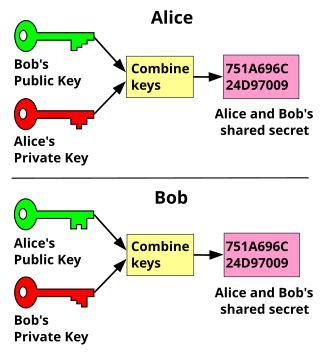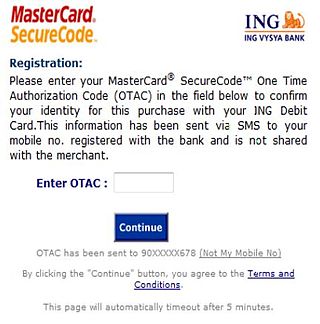Related Research Articles
The Secure Shell Protocol (SSH) is a cryptographic network protocol for operating network services securely over an unsecured network. Its most notable applications are remote login and command-line execution.

Authentication is the act of proving an assertion, such as the identity of a computer system user. In contrast with identification, the act of indicating a person or thing's identity, authentication is the process of verifying that identity. It might involve validating personal identity documents, verifying the authenticity of a website with a digital certificate, determining the age of an artifact by carbon dating, or ensuring that a product or document is not counterfeit.

Keystroke logging, often referred to as keylogging or keyboard capturing, is the action of recording (logging) the keys struck on a keyboard, typically covertly, so that a person using the keyboard is unaware that their actions are being monitored. Data can then be retrieved by the person operating the logging program. A keystroke recorder or keylogger can be either software or hardware.

A smart card, chip card, or integrated circuit card is a physical electronic authentication device, used to control access to a resource. It is typically a plastic credit card-sized card with an embedded integrated circuit (IC) chip. Many smart cards include a pattern of metal contacts to electrically connect to the internal chip. Others are contactless, and some are both. Smart cards can provide personal identification, authentication, data storage, and application processing. Applications include identification, financial, public transit, computer security, schools, and healthcare. Smart cards may provide strong security authentication for single sign-on (SSO) within organizations. Numerous nations have deployed smart cards throughout their populations.
In cryptography and computer security, a man-in-the-middleattack is a cyberattack where the attacker secretly relays and possibly alters the communications between two parties who believe that they are directly communicating with each other, as the attacker has inserted themselves between the two parties. One example of a MITM attack is active eavesdropping, in which the attacker makes independent connections with the victims and relays messages between them to make them believe they are talking directly to each other over a private connection, when in fact the entire conversation is controlled by the attacker. The attacker must be able to intercept all relevant messages passing between the two victims and inject new ones. This is straightforward in many circumstances; for example, an attacker within the reception range of an unencrypted Wi-Fi access point could insert themselves as a man-in-the-middle. As it aims to circumvent mutual authentication, a MITM attack can succeed only when the attacker impersonates each endpoint sufficiently well to satisfy their expectations. Most cryptographic protocols include some form of endpoint authentication specifically to prevent MITM attacks. For example, TLS can authenticate one or both parties using a mutually trusted certificate authority.
Login spoofings are techniques used to steal a user's password. The user is presented with an ordinary looking login prompt for username and password, which is actually a malicious program under the control of the attacker. When the username and password are entered, this information is logged or in some way passed along to the attacker, breaching security.

passwd is a command on Unix, Plan 9, Inferno, and most Unix-like operating systems used to change a user's password. The password entered by the user is run through a key derivation function to create a hashed version of the new password, which is saved. Only the hashed version is stored; the entered password is not saved for security reasons.

Key exchange is a method in cryptography by which cryptographic keys are exchanged between two parties, allowing use of a cryptographic algorithm.

Network security consists of the policies, processes and practices adopted to prevent, detect and monitor unauthorized access, misuse, modification, or denial of a computer network and network-accessible resources. Network security involves the authorization of access to data in a network, which is controlled by the network administrator. Users choose or are assigned an ID and password or other authenticating information that allows them access to information and programs within their authority. Network security covers a variety of computer networks, both public and private, that are used in everyday jobs: conducting transactions and communications among businesses, government agencies and individuals. Networks can be private, such as within a company, and others which might be open to public access. Network security is involved in organizations, enterprises, and other types of institutions. It does as its title explains: it secures the network, as well as protecting and overseeing operations being done. The most common and simple way of protecting a network resource is by assigning it a unique name and a corresponding password.
Single sign-on (SSO) is an authentication scheme that allows a user to log in with a single ID to any of several related, yet independent, software systems.

A one-time password (OTP), also known as a one-time PIN, one-time authorization code (OTAC) or dynamic password, is a password that is valid for only one login session or transaction, on a computer system or other digital device. OTPs avoid several shortcomings that are associated with traditional (static) password-based authentication; a number of implementations also incorporate two-factor authentication by ensuring that the one-time password requires access to something a person has as well as something a person knows.

A security token is a peripheral device used to gain access to an electronically restricted resource. The token is used in addition to, or in place, of a password. It acts like an electronic key to access something. Examples of security tokens include wireless keycards used to open locked doors, or a banking token used as a digital authenticator for signing in to online banking, or signing a transaction such as a wire transfer.
Logical Security consists of software safeguards for an organization’s systems, including user identification and password access, authenticating, access rights and authority levels. These measures are to ensure that only authorized users are able to perform actions or access information in a network or a workstation. It is a subset of computer security.
Mutual authentication or two-way authentication refers to two parties authenticating each other at the same time in an authentication protocol. It is a default mode of authentication in some protocols and optional in others (TLS).
There are several forms of software used to help users or organizations better manage passwords:
There are a number of security and safety features new to Windows Vista, most of which are not available in any prior Microsoft Windows operating system release.

Multi-factor authentication is an electronic authentication method in which a user is granted access to a website or application only after successfully presenting two or more pieces of evidence to an authentication mechanism: knowledge, possession, and inherence. MFA protects user data—which may include personal identification or financial assets—from being accessed by an unauthorized third party that may have been able to discover, for example, a single password.

Trusted Computer System Evaluation Criteria (TCSEC) is a United States Government Department of Defense (DoD) standard that sets basic requirements for assessing the effectiveness of computer security controls built into a computer system. The TCSEC was used to evaluate, classify, and select computer systems being considered for the processing, storage, and retrieval of sensitive or classified information.
A whole new range of techniques has been developed to identify people since the 1960s from the measurement and analysis of parts of their bodies to DNA profiles. Forms of identification are used to ensure that citizens are eligible for rights to benefits and to vote without fear of impersonation while private individuals have used seals and signatures for centuries to lay claim to real and personal estate. Generally, the amount of proof of identity that is required to gain access to something is proportionate to the value of what is being sought. It is estimated that only 4% of online transactions use methods other than simple passwords. Security of systems resources generally follows a three-step process of identification, authentication and authorization. Today, a high level of trust is as critical to eCommerce transactions as it is to traditional face-to-face transactions.
Biometric tokenization is the process of substituting a stored biometric template with a non-sensitive equivalent, called a token, that lacks extrinsic or exploitable meaning or value. The process combines the biometrics with public-key cryptography to enable the use of a stored biometric template for secure or strong authentication to applications or other systems without presenting the template in its original, replicable form.
References
- ↑ 3.2.2.1.1 Trusted Path: The TCB shall support a trusted communication path between itself and user for initial login and authentication. Communications via this path shall be initiated exclusively by a user., Orange Book
- ↑ ISO/IEC 15408-1, Information technology — Security techniques — Evaluation criteria for IT security — Part 1: Introduction and general model, 2005
- ↑ Yee, Ka-Ping (2002). "User Interaction Design for Secure Systems". pp. 278–290. CiteSeerX 10.1.1.65.5837 .